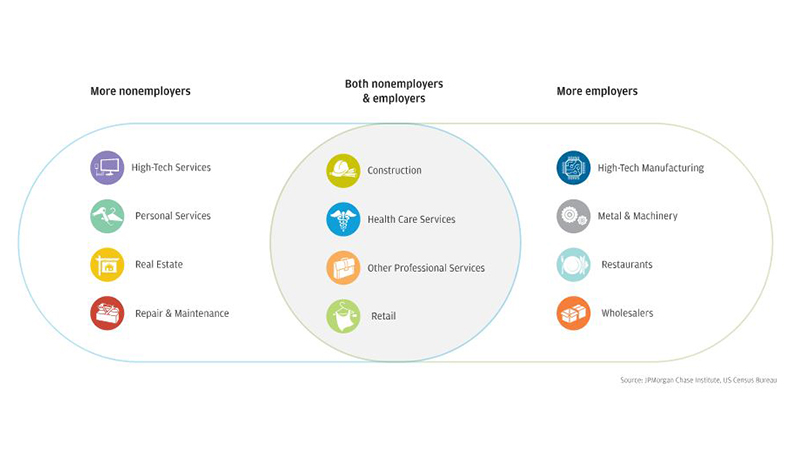As Figure 3 shows, the overwhelming majority of small businesses in the small business sector are nonemployer businesses. Of the 28.4 million small businesses in the U.S. in 2016, 23 million had no employees. Moreover, nonemployer businesses provided some degree of economic livelihood to 23 million of the 160 million people in the U.S. labor force. In this sense, nonemployer firms of all ages can impact the U.S. economy by creating wealth and income for the households of their owners, with young nonemployer businesses playing the largest role.
Moreover, nonemployer businesses also show a greater extent of dynamism than employer businesses, exhibiting higher entry rates, though higher exit rates as well. Given the size and vitality of this segment, policies directed at these business owners could affect the economic lives of significant numbers of households, especially to the extent that the policies address the unique challenges small nonemployers face.
In contrast, Figure 3 shows that most people who work for a small business work for an employer business—nearly half at mature employer small businesses. The significant role of these employer small businesses in generating and sustaining employment frequently draws the attention of policymakers significant role. While nonemployer businesses overshadow employer businesses in absolute counts of businesses and in their share of new firm formation, employer businesses account for larger shares of overall revenues, employment and job creation, and innovative activity. In 2014, 57.5m people worked for small employer businesses with fewer than 500 employees.
Notably, a very small share of businesses show signs of significant growth—as a result, these firms make up a tiny fraction of the overall universe of small businesses, both in terms of firms and employees.
While the typical employer small business makes a greater aggregate contribution to the economy than the typical nonemployer business, the demands of employment can make them more fragile as well. In The Ups and Downs of Small Business Employment, we found that employer small business operate with substantially less cash liquidity than nonemployer businesses, when their cash liquidity was scaled against their typical cash outflows, as depicted in Figure 4.







